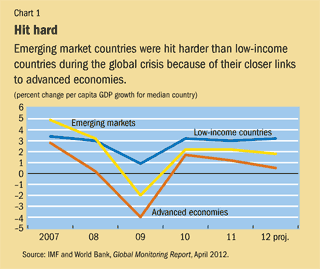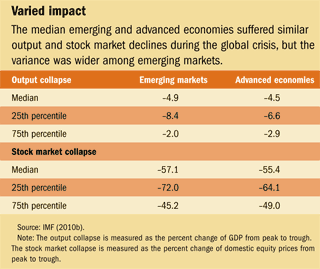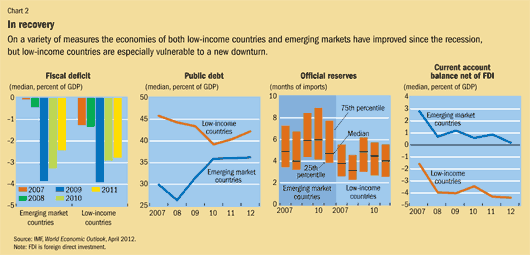Bystanders at the Collapse
Finance & Development, June 2012, Vol. 49, No. 2
Sarwat Jahan and Brad McDonald
Emerging markets and low-income countries weathered the global recession. Can they survive further shocks?

EMERGING market and low-income economies had unprecedented strong economic performance in the period before the global financial crisis. The experience varied across countries, but from 2003 to 2007, annual inflation-adjusted GDP growth in both groups of countries averaged 7 to 8 percent—well above rates of the 1990s. Inflation was successfully reduced to single digits. These economic achievements owe much to persistent structural reforms that made economies more competitive and resilient and to improved fiscal and monetary policies. This sustained economic growth also translated into lower poverty rates—a key target of the Millennium Development Goals set by the United Nations in 2000 (IMF and World Bank, various years).
Because many emerging markets and low-income countries were in strong economic shape, they were able to take steps to counter the global recession that began in 2008 as a direct aftermath of the financial crisis in advanced economies. These innocent bystanders, if you will, were able to shake off the recession far faster than advanced economies. Moreover, many benefited from a quick recovery in commodity prices.
But would these bystanders do as well in the event of another global downturn or other serious economic shock? That could depend on how well they prepare.
Caught in a broadside

The global economic and financial crisis originated in the advanced economies, but emerging market and low-income countries were, for a time, caught in its broadside (see Chart 1 and table). Their rates of growth fell, although the slowdown was less pronounced in the low-income countries. The turmoil of the global crisis was transmitted to emerging market and low-income countries through several major channels: demand for their exports dropped, foreign exchange markets grew more volatile, trade finance and other forms of credit tightened, and foreign direct investment slowed. And the global gloom and uncertainty cast a chill over domestic investment as well. All this came on the heels of the 2007–08 surge in food and fuel prices, which—except for commodity exporters—had begun to weaken trade balances and official reserves positions and necessitated increased social spending.

Stronger policies before the crisis made the difference in recovery. Low to moderate inflation, comfortable international reserves, strengthened fiscal accounts, and reduced debt provided the “policy space” that many countries needed to undertake active policies to combat the recession.
Although monetary authorities in many emerging markets and low-income countries at first tightened policies to bolster confidence and contain the impact of the financial crisis, as the risk that the financial crisis would spill over to the real economy became more palpable, central banks cut interest rates and allowed greater exchange rate flexibility. Nearly three-quarters of emerging markets and more than half of low-income countries loosened both monetary and fiscal conditions in 2009.
The change in fiscal conditions was especially sharp, with the median fiscal deficits among emerging market and low-income countries expanding by about 3 percent of GDP (see Chart 2). To a large degree this reflects the effects of “automatic stabilizers” such as weaker revenues (taxes fall when output declines). Had fiscal positions been weaker and debt levels higher—as in the past—governments would have had to increase taxes or reduce spending—or both. In addition to letting automatic stabilizers function, those with bigger buffers responded actively with more spending.

Unprecedented response
For the low-income countries, the fiscal policy response was unprecedented. They did not enter the crisis from as strong a macroeconomic position as the emerging markets, but they were in much better shape than during previous crises. Official reserves in the typical low-income country were about double their level at the start of earlier crises. And inflation rates, fiscal deficits, current account deficits, and external debt levels stood at about half of where they were at the start of earlier crises (IMF, 2010a).
During earlier crises, such as in 1982 and 1991, low-income countries had to cut their fiscal deficits. In 2009, the typical low-income country increased its fiscal deficit by 2.7 percent of GDP. Real (inflation-adjusted) spending rose 7 percent. More than half of the financing needs resulting from the higher fiscal deficits were met from domestic sources; however, the IMF and other external creditors stepped in to provide large amounts of concessional (below market interest rates) and other financing.
The impact of the performance of advanced economies on other countries was demonstrated again in 2010 and 2011. The global recovery in 2010 magnified the effect of the countercyclical policies, with most low-income countries and especially emerging markets rebounding sharply. Capital flowed again and credit growth rose, and many emerging markets experienced large increases in industrial production. Inflation became a rising concern in emerging markets and some low-income countries, especially when the recovery began to boost global commodity prices. But again in 2011, financial turmoil and the economic slowdown spilled over to emerging markets and low-income countries—underscoring that while their interdependence may have weakened somewhat, their robust growth and rapid development still depend on strong growth in the advanced economies (Canuto and Leipziger, 2012).
Risks and mitigating measures
Despite weathering the crisis well, emerging markets and low-income countries must be prepared to deal with further volatility in the global economy. As of early 2012, it appears that the euro area may enter a mild recession, and other advanced economies could experience weak and bumpy growth. Adverse spillovers from advanced economies to emerging market economies can cause continued moderation in emerging market growth. Other risks that loom globally include an adverse oil supply shock or reduced growth potential among the emerging markets themselves, which would also affect low-income countries because of the increased economic ties between the two groups of countries. Growth in most low-income countries may have rebounded, but they remain vulnerable, especially to commodity price swings and other global price shocks. Both emerging economies and low-income countries must follow prudent policies to ensure their resilience.
Paramount for emerging economies is steady navigation toward a soft landing as domestic growth moderates amid volatility in capital flows, potential credit booms, and a possible deteriorating external environment. Circumstances differ across these countries: In those with diminishing inflation pressure (such as most of Latin America), monetary policies can be eased to address downside risks and, where necessary, should be complemented with enhanced financial supervision to guard against overheating in sectors such as real estate. Where inflation pressure is easing, fiscal positions are sound, and there are significant external surpluses, there is space for increased expenditure—including, in some cases, social spending (IMF, 2012a). In other economies, notably in the Middle East and North Africa, a key issue is how to promote strong, sustained, and inclusive growth, with enough private sector jobs to absorb a fast-growing labor force, and develop strong institutions that ensure good governance. Where policy space is more limited, for example by inflation pressures, a more cautious stance toward policy easing is needed.
Low-income countries face a difficult policy balancing act. In most low-income countries macroeconomic policy buffers are weaker than in 2008. Fiscal deficits and debt are higher than before the crisis, indicating that the countries will be less able to pursue a countercyclical fiscal response to mitigate adverse effects of another shock. Since 2009, current account deficits (net of foreign direct investment) and fiscal deficits have widened, and stocks of foreign reserves (relative to imports) have declined. Until buffers such as these are rebuilt, low-income countries will be less well positioned to cope with further external shocks (IMF, 2010a and 2011a). If foreign aid is reduced because of budget issues in advanced economies, low-income countries become even more vulnerable. Low-income countries will have to gradually reduce deficits and debt while gradually building up foreign exchange reserves. But at the same time, these countries face acute spending needs for growth-enhancing investments and for social spending.
Resources used to rebuild buffers cannot be used for investments to promote future growth or to meet immediate development needs. But there are ways that low-income countries can deal with this trade-off—such as by strengthening domestic revenues and improving their systems for managing public spending. Low-income countries can put in place more flexible and robust social safety nets so that if a shock hits, transfers can be channeled promptly and more cost-effectively to vulnerable groups. Over the longer term, low-income countries can pursue reforms to encourage domestic saving and deepen their financial systems. Increases in both the volume and quality of public infrastructure investment are needed, as are investments in human capital through effective health and education policies (IMF, 2012b).
In addition, countries can begin to use financial markets to hedge against risk. Low-income countries can increase their use of market hedging products, such as disaster insurance and debt instruments with shock-contingent repayment terms that can soften the impact of those shocks (IMF, 2011b). ■
Sarwat Jahan is an Economist and Brad McDonald is a Deputy Unit Chief in the IMF’s Strategy, Policy, and Review Department.
References
Canuto, Otaviano, and Danny Leipziger, 2012, “Ascent after Decline: Challenges of Growth,” PREM Economic Premise, No. 75 (Washington: World Bank).
International Monetary Fund (IMF), 2010a, “Emerging from the Global Crisis: Macroeconomic Challenges Facing Low-Income Countries” (Washington).
———, 2010b, “How Did Emerging Markets Cope in the Crisis?” (Washington).
———, 2011a, “Managing Global Growth Risks and Commodity Price Shocks—Vulnerabilities and Policy Challenges for Low-Income Countries,” IMF Policy Paper (Washington).
———, 2011b, “Managing Volatility in Low-Income Countries—The Role and Potential for Contingent Financial Instruments,” IMF Policy Paper (Washington).
———, 2012a, “Global Economic Prospects and Policy Changes,” prepared by IMF staff for Meeting of G20 Finance Ministers and Central Bank Governors, February 25–26.
———, 2012b, “Low-income Countries Remain Vulnerable in Global Downturns,” IMF Survey, January 10.
———, and World Bank, various years, Global Monitoring Report (Washington).


